
Gulf Coast offers seven ecosystems
EVERGLADES CITY, Fla.— It’s a pleasant Sunday noon and the parking lot at the Gulf Coast Visitor’s Center is already close to full.
A small group of elderly visitors manages from their cars to the gift shop, apparently to obtain passes for one of the many boat tours offered each day. A short time later, they emerge and proceed to board one of the moored tour boats before it departs, sputtering out onto the bay.
It’s almost the end of the year, and many people are likely here to view the manatees that will be out and about as they winter in the warm Florida waters.
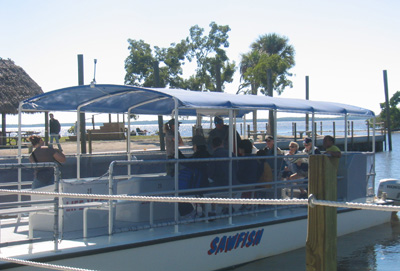 |
A tour boat prepares to depart from the Gulf Coast Visitor Center of Everglades National Park (Photos by Gerad Teague). |
Gulf Coast volunteer Steve Dukovich said that Everglades National Park, a 1.3 million acre preserve, attracts people from across the world who come to see, as renowned Everglades author Marjorie Stoneman Douglas once called it, “one of the unique regions of the world.”
“I get the opportunity to meet people from around the world, literally,” said Dukovich. “The Canary Islands, Africa, Ireland, England, Germany … they have heard about the Florida Everglades and just wish to see what it is, how it works.”
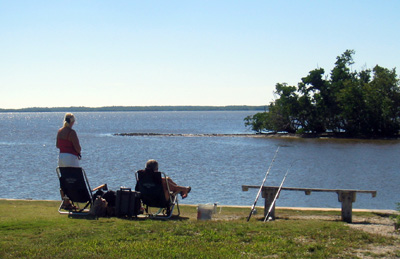 The park itself is a composition of seven different ecosystems.
The park itself is a composition of seven different ecosystems.
These ecosystems range from wood hammocks and hardwood trees to marshland and pine and cypress woods.
The park provides a conducive habitat that boasts a wide variety of wildlife, including alligators, dolphins, and manatees.
It also serves as an important refuge for some of the over 60 threatened or endangered species that can be found in the Everglades.
The Gulf Coast park area, Dukovich noted, is important because it functions as “the gateway to the 10,000 islands,” referring to the archipelago just off the coast that serves as a popular tourist destination.
Aside from educating visitors about the Everglades, Gulf Coast provides daily motorboat tours and also rents canoes to the more intrepid of visitors. There are two varieties of boat tours offered: the islands tour and the mangrove backwoods tour.
| Guests look at the exhibits in the Gulf Coast Visitor Center of Everglades National Park (Photos by Gerad Teague). | 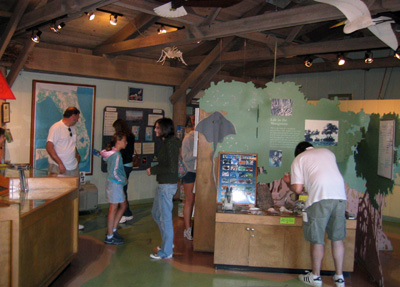 |
“You have two different aspects of the Everglades,” said Dukovich. “Water and mangrove trees are the norm, but its somewhat different going out through the islands and going up through a tributary into the woods.”
In general, the backwoods tours explore regions where the water is mostly fresh, and hence serves as a habitat for alligators and other wildlife that subsist in a such an environment.
Of course, the island tours offer some incredible sights of their own, including the opportunity to witness dolphins as they cavort in the ocean waters.
“They love to play around the boats,” said Ed Smith, who has lived in the region for the better part of 70 years and currently works in the gift shop next to the Visitor’s Center.
“[The Everglades are] completely different from anyplace you go. It’s still got a lot of wild in it,” Smith said. “A lot of different wildlife.”
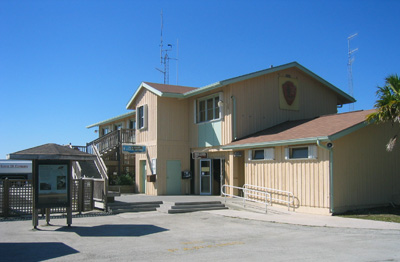 |
The Gulf Coast Visitor Center of Everglades National Park (Photos by Gerad Teague). |
The Visitor’s Center itself is a modest-sized building abutting the bay. On the first floor is the Gift Shop, which, surprisingly enough, offers a host souvenirs and accoutrements that tourists can purchase to commemorate their visit. Visitors can also purchase refreshments or schedule a boat tour here.
On the second floor is what could be described as the educational exhibit, which outlines much of the history of the region, as well as detailing the types of wildlife that exist in the area. Friendly volunteers, such as Dukovich, are here to answer any questions one might have about the park itself.
Of course, not everyone comes to explore the waters of the Everglades; many are content just relaxing in the picnic shelter or on fields that abut the visitor’s center, with perhaps some fishing on the side.
Brian Deersing, a resident of Key Largo, said he visits Everglades City fairly often.
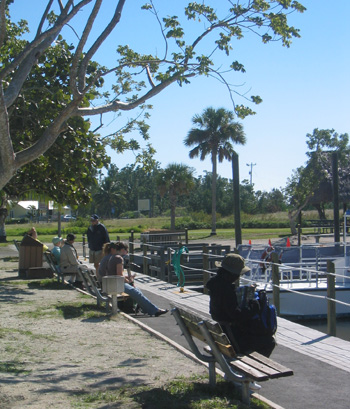 As a former a canoe guide with Metro-Dade County parks in Miami, he comes to experience the rarity that is the Everglades, a park and habitat that is entirely unique in North America.
As a former a canoe guide with Metro-Dade County parks in Miami, he comes to experience the rarity that is the Everglades, a park and habitat that is entirely unique in North America.
“I was just taking it in for a while … the general solitude of it all,” Deersing said. “It still has a relatively countryside atmosphere.”
David and Sue Parkin, originally from England, have, in recent years, been dividing their time, spending half the year in the U.K. and half at their winter home in Naples.
They said they have come down to Everglades City for many years, usually to grab a bite to eat, look at wildlife, or go fishing.
Today, they have come to fish as they usually do once a week, relaxing in their lawn chairs, waiting patiently for a tug on their fishing lines. The Everglades serve as a somewhat unique destination, they said, far removed from the ever-expanding urban development that has come to characterize much of South Florida.
“When you go for a few days, it’s fine, but that’s enough,” said David Parkin, referring to a recent foray the couple had taken to Miami. “
“Here, it’s a change. It’s much more relaxed. There’s nowhere else like it, really.”
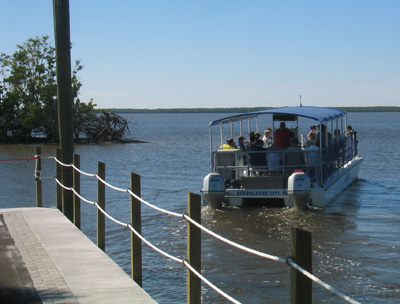 If You Go
If You Go
Hours
The Gulf Coast Visitor Center is open daily from 8 a.m. to 4:30 p.m. Nov. 1 to April 16, and 9 a.m. to 4:30 p.m. April 17 to Nov. 1.
Directions:
The Gulf Coast Visitor Center is located about five miles south of U.S. 41 (also known as the Tamiami Trail) from Miami and from Naples or Marco Island. Turn south on State Road 29 to Everglades City.
Visitors arriving from I-75 (also known as Alligator Alley), should take exit 80 (State Road 29) south and proceed 20 miles to Everglades City. Once in Everglades City, follow the signs to the park. The Visitor Center is on the right.
Activities
Picnicking, boat tours, canoeing, fishing, water sports.
Contact information:
Phone 239-695-3311; http://www.nps.gov/archive/ever/visit/activ-gc.htm.

Comments are Closed